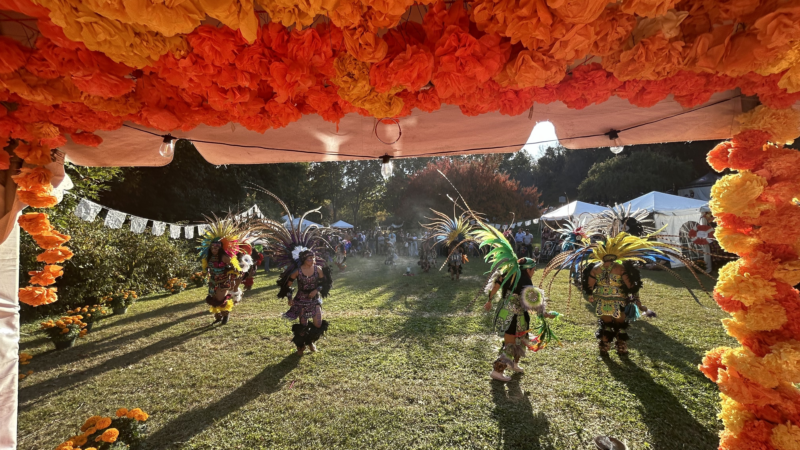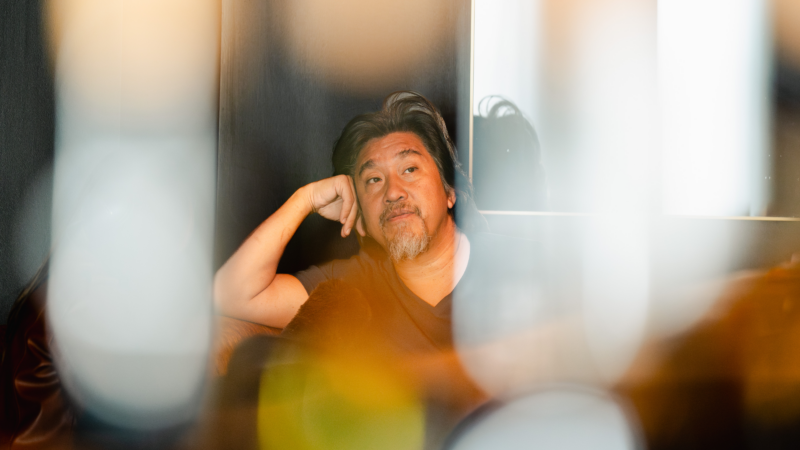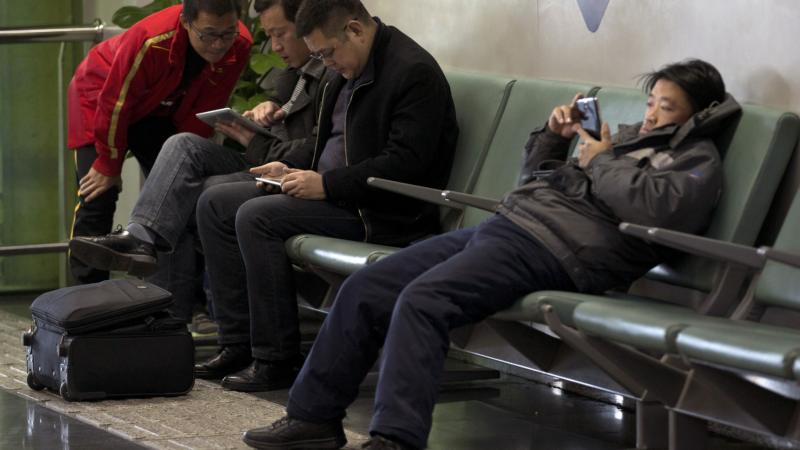At a historic cemetery in the South, a Dia de los Muertos festival takes root
RALEIGH, N.C. — The earthy smoke of Mexican copal incense wafts around the entrance of the Historic Oakwood Cemetery in Raleigh. It’s a way to keep bad vibes away and invite good ones for Día de Oakwood, a major Day of the Dead art installation and festival here, said Peter Marin.
“It’s like cleaning your house before the guests arrive,” says Marín, a Mexican-American artist who now calls North Carolina home, and helps organize the weeklong festival.
“When the Spanish arrived in the Americas, it was too expensive to import frankincense and myrrh. So they started using Copal in religious ceremonies.”
It’s an example of syncretism — things coming together, Marín said. That’s as true in pre-Columbian Mexico as it is here in this 155-year-old cemetery, where an indigenous Mexican tradition has found a home not far from the burial plots of Confederate generals.
The ceremonial copal — with the assistance of hundreds of glowing cempasúchil flowers, of course — will attract the souls of the dead on November 1 and 2, when Day of the Dead is celebrated in Mexico and the U.S.

(Aaron Sanchez-Guerra | NPR)
“Día de Oakwood” began nearly a decade ago, with a small ofrenda at a local Mexican restaurant. Ofrendas are built for Día de los Muertos to invite the dead back, so they can visit who they left behind on Earth.
Angela Salamanca, the restaurant’s owner, later moved to the ofrenda to the Oakwood cemetery — and what happened next surprised her.
“You have to come and see what’s happened,” she recalled the cemetery director saying. “All these people are bringing pictures to the ofrenda.”
Over time, more and more people from Raleigh — including people who had never celebrated Día de Los Muertos — started leaving pictures of their beloved dead on Salamanca’s ofrenda.
“I even had somebody call and ask me to print a picture of a World War II veteran that is buried here in the cemetery and put it on the ofrenda,” Salamanca said. “And when I came back, sure enough, there were 20 extra pictures.”
She continued: “It helps me with my grief and my process, to be able to hold these for other people.”

(Aaron Sanchez-Guerra for NPR.)
This year, Día de Oakwood has scaled up: 10 altar offerings, or ofrendas, featuring pieces made by students from six different schools under the direction of Marín.
Longleaf School of the Arts made an altar offering to the 100 people who died in the recent Hurricane Helene that ravaged Western North Carolina. Raleigh Charter High School built a public ofrenda to deceased pets.
Marín has made ofrenda installations before at museums and galleries. But making it in a cemetery feels more authentic to the tradition, he said.
“The museum is a good place, but takes it out of context, right?” said Marín. “Because there’s something about it being in situ, that this is where this happens. This is the place for this.”
For him, it’s about cultural appreciation of an evolving grieving tradition that’s taken root in a growing Southern city.
“People are here because they want to learn,” said Marín. “If we don’t do something with that openness, we’re doomed. If we close ourselves off… se acabó.”
“Se acabó,” he says. “It’s over.”
For Marin, it’s about keeping the door open to tradition — and to each other.
“Death is the only thing that binds us for sure, and if we can celebrate death together, well, we’ve taken a huge step.”
This story was produced through a collaboration between NPR and Religion News Service.
U.K. Conservatives pick Kemi Badenoch as their party’s new leader
The party elected Kemi Badenoch as its new leader as it tries to rebound from a crushing defeat that ended 14 years in power. She is the first Black woman to lead a major British political party.
Chef Edward Lee reflects on ‘Culinary Class Wars’, identity and his next chapter
After three decades in Southern cuisine, Lee's next culinary chapter explores Korean American cooking, moving beyond traditional recipes and fusion concepts.
Iran’s supreme leader threatens Israel, U.S. with ‘crushing response’ to Israeli attack
Iran's supreme leader threatened Israel and the U.S. with “a crushing response” over attacks on Iran and its allies. The Pentagon said Friday that more U.S. forces would be coming to the region.
Opinion: Don’t get ‘river-crabbed!’ How China is cracking down on punny dissent
China's government is censoring puns and wordplay on-line. NPR's Scott Simon explains why double meanings are a problem for Beijing.
As ACA sign ups start, more Americans have health insurance than ever. Will it last?
Enrollment in Affordable Care Act health plans has grown every year of the Biden administration, leading to record low numbers of people who are uninsured.
Here’s why we’re disappointed with ‘Here’: It’s more complicated than it is good
Here, starring Tom Hanks and Robin Wright, was adapted from a millennia-spanning graphic novel. But it's a technically and narratively difficult story on-screen and the result is crowded and confusing.





